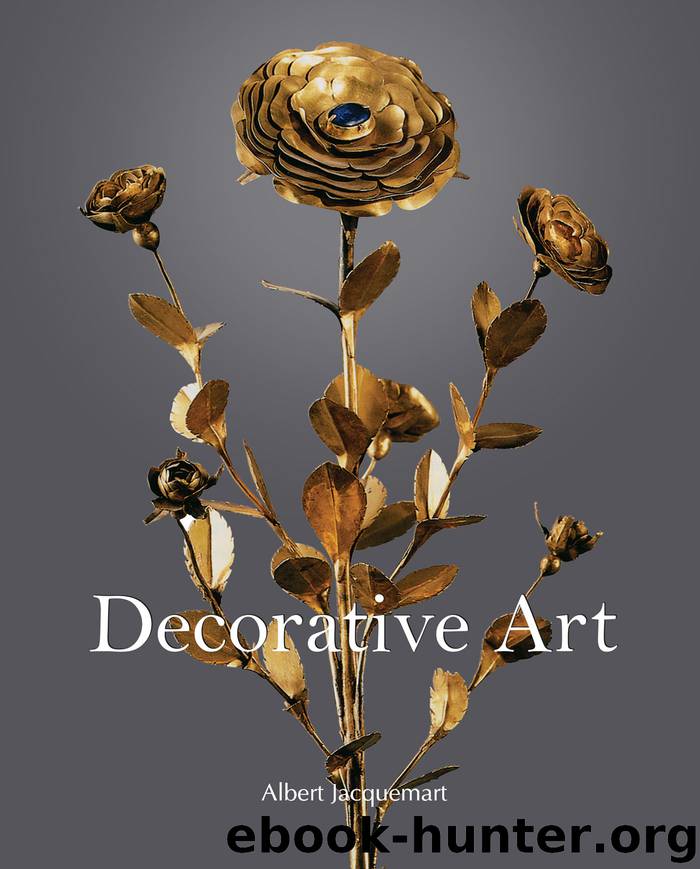Decorative Art by Albert Jaquemart

Author:Albert Jaquemart [Jacquemart, Albert]
Language: eng
Format: epub
ISBN: 9781783107872
Publisher: Parkstone International
Pierre Delabarre, Stone ewer,
1st century CE or BCE, c. 1630 (base).
Sardonyx, enamelled gold, 28 cm.
Musée du Louvre, Paris.
Light plate formerly
belonging to Marie de Médici, c. 1630.
Silver gilt, cameos, sardonyx, 45 cm.
Musée du Louvre, Paris.
Tortoise shell, piqué, and posé d’or
We need not consider tortoise shell as a material at this point for we have already seen it employed in veneered furniture. The Middle Ages, following an Oriental custom, used tortoise shell in rods and small cuttings to enrich the work upon ivory caskets. It was reserved for modern times to discover the means of softening the shell so as to form, by soldering or joining the pieces while warm, large tables, or to mould it into vases, candlesticks, caskets, boxes of various shapes, more or less twisted into various utensils. Thus, tortoise shell was deemed worthy to serve as a substrate to the most precious works and to vie with the productions of the goldsmith and jeweller. It was the 17th century, about the time of Louis XIV, when work in this style received its highest development. Laurenti of Naples, seems to have contributed most to this result by softening the pliant shell to conform to every caprice of his imagination.
But let us leave the consideration of the shell as a material for a moment and deal with the modes of its ornamentation. The most important, termed posé d’or, consisted of inlaying a mass of gold in the tortoise shell to represent the silhouettes of figures, monuments, canopies, and arabesques, the details of which were subsequently chased with extreme care. The piqué complements the first decoration and consists of driving extremely small golden nails into the shell, set close together to form patterns of foliage, flowers, or shells, which surround the chased designs or serve to complete them. This imparted the utmost delicacy to the whole. Where the diameter of these golden nails was increased, either to obtain foliage of bolder character or to give a certain prominence to diamond-shaped backgrounds, the work received another name: clouté d’or.
Tortoise shell piqué and posé d’or was certainly in favour with French artists and its use was in style for a long time. We see it pass from the style of Louis XIV to that of Louis XV through a succession of small objects of very exquisite workmanship, especially watch cases.
The former Sechan collection contained a foiled and cut plate, its case of red morocco, in which it was enclosed, bears the coat of arms and fleur-de-lis of Louis XIV, which sufficiently proves the high esteem in which this piece was held. These exceptional examples have drawn us far away from objects piqué and posés d’or, which collectors can easily find and form the basis of all works in this genre. Next we’ll move on to the boxes and snuff boxes, visiting the jewellery boxes, cases, diaries, ring boxes, and costume jewellery which has always been the glory of the Parisian industry.
Download
This site does not store any files on its server. We only index and link to content provided by other sites. Please contact the content providers to delete copyright contents if any and email us, we'll remove relevant links or contents immediately.
POP by Steven Heller(3308)
Japanese Design by Patricia J. Graham(3110)
The Power of Broke by Daymond John(2897)
Architecture 101 by Nicole Bridge(2765)
Indistractable: How to Control Your Attention and Choose Your Life by Nir Eyal(2335)
Fusion 360 for Makers by Lydia Sloan Cline(2308)
Batik by Rudolf Smend(2124)
Actionable Gamification: Beyond Points, Badges, and Leaderboards by Yu-kai Chou(2124)
Origami Art by Michael G. Lafosse & Richard L. Alexander(2065)
Homebody by Joanna Gaines(2033)
Whiskey in a Teacup by Reese Witherspoon(1936)
Worn in New York by Emily Spivack(1927)
Feng Shui by Stephen Skinner(1902)
Austin Kleon by Steal Like an Artist(1889)
Simple Gatherings by Melissa Michaels(1857)
Don't Make Me Think, Revisited: A Common Sense Approach to Web Usability by Steve Krug(1826)
Hygge: The Danish Art of Happiness by Marie Tourell Søderberg(1694)
The Joy of Hygge by Jonny Jackson(1687)
The Laws of Simplicity by John Maeda(1568)
